Apple's Bumper Case
The iPhone 4 is Apple's second product to launch with first party accessories. Like the iPad before it, the iPhone 4 is available with an Apple fabricated and sold case, dubbed the "bumper." At launch, this was the only case available. Most Apple stores (and online) only had black in inventory, though I'm told a few also had pink in stock. As of right now, the Apple store shows other colors shipping on July 16th - white, pink, orange, green, and blue eventually. I just went with black.
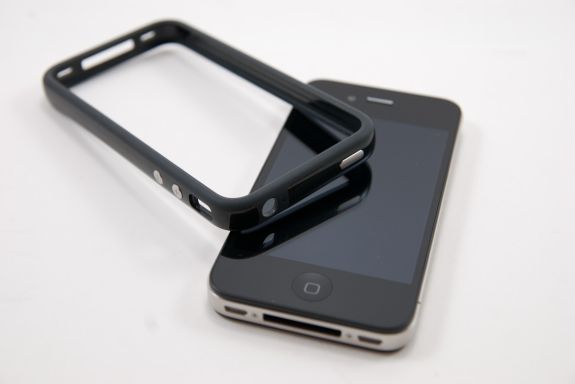
The bumper is an interesting beast. For $29.00, you get a hard plastic strip that runs atop the stainless steel antenna band, completely around the phone. On the outside of the hard plastic are two stiff rubber bands that seal over the side of the phone. If the Otterbox Defender is a bomb proof suit for iPhones, Apple's bumper is more like a slightly-scandalous bikini. It's literally just a continuous strip of material.
Apple brings the exterior metal volume and standby buttons out to the edge of the phone, and from what I can tell they're also metallic.
Buttons are metal and brought through the case, except the vibrate/silent switch.
Inside the case, there's a felt-like mask which rests atop the buttons and aligns itself up. It works surprisingly well, and the buttons feel like those on the device itself. There's no gap inbetween - hey, the buttons just work.
Putting it on is a little bit of a struggle. I've found the best way is to insert the top, standby button side first (so you don't accidentally turn it on and off while inserting it), and then shove the bottom part in. After you've got it in, there's just a bit of massaging to get the rubber seats settled, and then you're good to go. It's very snug, there's no flexing.
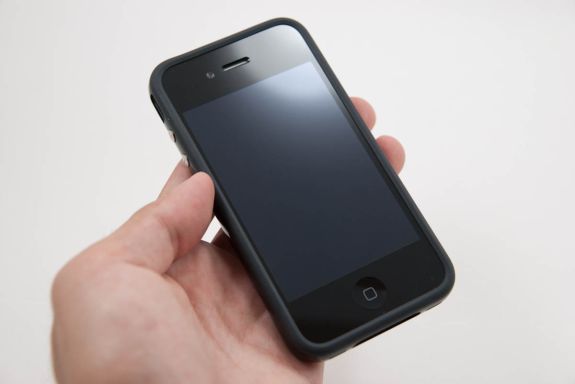
At the top, there's a break in the hard plastic for the headset jack. Instead, this is entirely rubber. No doubt this is to allow jacks that come out and have a 90 degree bend to be inserted, something we're all too familiar with being a problem on previous iDevices. There's a tiny hole next to it you want to be absolutely certain isn't blocked for the noise canceling microphone.
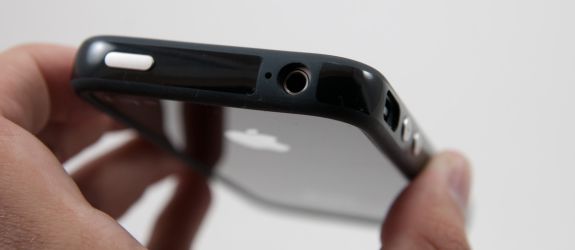
The nice thing about the rubberized strips is that you get a grippy surface to hold the phone with, and you raise the front and back glass panes about a millimeter off the surface you're resting it on when you lay it down flat.
The idea of having a glass back is fine and dandy until you lay the iPhone on another glass surface directly. The result (if both surfaces are very clean) is that the two will come in optical contact and become very hard to pry apart. It's the same sort of reason coasters aren't glass - the two seal together, and become difficult to separate. Not to mention any particulates underneath will make those hairline scratches (sleeks) I talked about before. Even the strongest of glasses will get micro scratches when rubbed in optical contact with other glasses. It's obvious that raising both the front and back were design objectives here.
Look ma, I can rest the phone face down and not scratch it up!
Apple's bumper case is unique that it doesn't cover the back of the phone. At all. If you prefer a case that covers every square inch of the device and offers total protection, don't get the bumper and instead wait for something else. If you want to show off as much of the iPhone 4's design as possible, Apple has done it with the bumper. If you already purchased an iPhone 4, well, you know that outside of a plastic bag or a rubber band, the bumper is really the only option.
Like we talked about before, the other hugely notable benefit is that the bumper insulates the stainless steel band from being detuned by your meatbag extremities (read: hands). Instead of a 24 dB drop, you'll incur a 10 dB drop completely in line with every other cellular phone ever made.
The only problem with the bumper is the dock connector port. It's about a millimeter too small.
That doesn't fit inside. Frustrating? Yes.
The unfortunate result is that all of my third party accessories don't fit. My Alpine iDA-X001 head unit in the car, three different vehicle accessory port car chargers with dock connectors, all my third party cables, and not to mention docks all don't fit.
If you've rolled with other cases, this is an all too familiar story that seems to repeat every single release, but it's frustrating in this case because the connectors don't match up by seriously under a millimeter. You can jam the dock connector in, but it doesn't go far enough inside to snap into place, and comes right back out.
The result is that I drive around with the bumper case halfway off, like this:
It's not the end of the world, but I would have to file down that edge a half millimeter on both sides to make my accessories work again. Considering just how much the bumper improves signal and protects against accidental scratching, it's arguably a must have accessory. One that should maybe be given away with every iPhone 4 purchase. But you already know our thoughts on that.
No doubt within a month or two the usual assortment of iPhone cases will pop up again, tweaked to meet the iPhone 4's slightly thinner dimensions. For now, however, the bumper is essential.



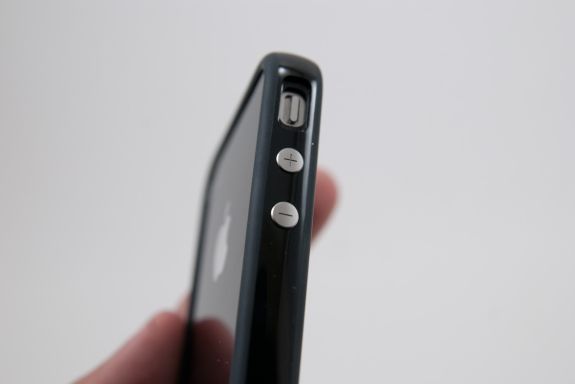


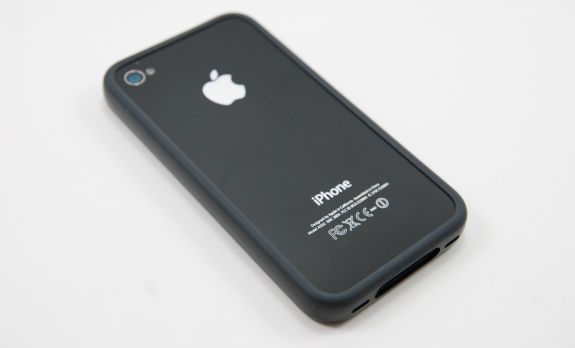
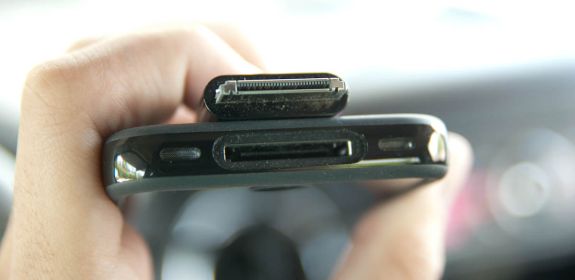
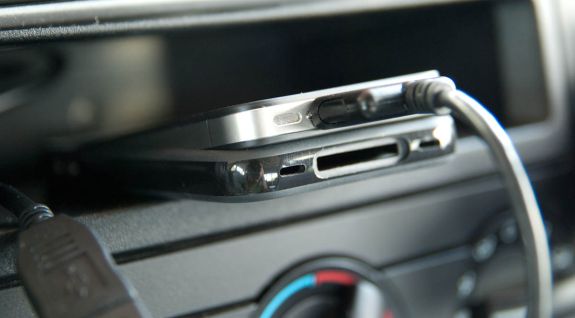








270 Comments
View All Comments
JAS - Wednesday, June 30, 2010 - link
The build quality of the iPhone 4 is outstanding. It reminds me of Nagra (Swiss-made) professional tape recorders I have used. Very solid.The edges of the iPhone 4 are not as smooth as those on the iPhone 3GS; but they aren't "sharp" or prone to cutting your pants when you slide the device into your pocket.
Still, I would want to use a rubber/silicone "skin" on the iPhone 4, not just a bumper, primarily to improve its grasp.
jsbruner - Wednesday, June 30, 2010 - link
I see the reception bar issue as well but do not experience any dropped calls because of it. However the biggest issue I have is with the proximity sensor. I have accidentally hung up numerous times because the screen lock turns off and the buttons become active. I watched myself in a mirror talking and I see the phone flickering on and off. Have you seen this issue at all? Would the bumper minimize this issue?Great article.
Wolfpup - Wednesday, June 30, 2010 - link
While in theory I'd love higher resolution displays on monitors, in practice they're already too high, and can't get any higher until somehow operating systems are able to offer true resolution independence where ANY program (even if it's written in 1988) will be flawless scaled so it's the right size at a given resolution. So far the ONLY example in the computer world of this being done right is on Palm devices, where they just quadrupled the resolution and on older programs 1 pixel = 4 real pixels. Presumably it's the same on iOS.But until OSes can do that that successfully on ANY content on ANY monitor at ANY resolution, raising the resolution is a TERRIBLE idea, as we're already WAY past the point of usability on a lot of displays, since stuff just keeps shrinking rather than adding detail.
inperfectdarkness - Wednesday, June 30, 2010 - link
"If there's one thing I hope the iPhone 4 display does, it's generate demand for 300 PPI level desktop displays - the era of 110 PPI displays being the norm needs to end now."i could not have said it better. 1080p on a 17" screen is pathetic for a laptop.
minememy21 - Wednesday, June 30, 2010 - link
I registered just for the sole purpose of saying thank you to Brian and Anand.I really appreciate the amount of work and objectivity you've put in this review. I don't know of any other site with the same level of dedication and thoroughness.
Please don't pay attention to the few, vocal, and overly sensitive anti-apple crowd and just continue writing the way you do.
HilbertSpace - Wednesday, June 30, 2010 - link
"Perhaps even use diamond vapor deposition (like they did with the glass screen atop the iPhone 3GS) to insulate the stainless steel from users." -The Real Story on iPhone 4's Antenna.There's no way apple used physical vapor deposition (PVD) on the iPhone 3GS, way too expensive! Supposedly a Nokia Vertu phone adds a TiC coating - the cost - oh only ~$15000!
gronkman - Wednesday, June 30, 2010 - link
The word on the grapevine is that the antenna issue will be dealt with by an upcoming software update. What I am interested in is whether it will really change the antenna attenuation, or whether it will "fix" the bars just by not showing the bar degradation. I'm hoping AT will do an in-depth look at the update when/if it comes out.thomas.magnum - Wednesday, June 30, 2010 - link
I am not sure what you mean when using 40% in the context of the bar. But I think you need to improve the discussion of dB. Because it runs on a log scale, changes in dB are more complex than just looking at dB1-dB2 and computing percentage. You really need to think about 10^(dB/10). I would bet that the bars are setup to be representative of a dB scale. NOT simple percentages base on dB numbers, like you're trying to do.The0ne - Wednesday, June 30, 2010 - link
Your comment reminds me of richter scale :) Most people will look at 6.0 and 7.0 and say oh that's nothing hahaha If only they knew they'll be completely shocked. Sorry, I had a good laugh out of this.strikeback03 - Thursday, July 1, 2010 - link
Of course that is also assuming they think the Richter scale is still in use.